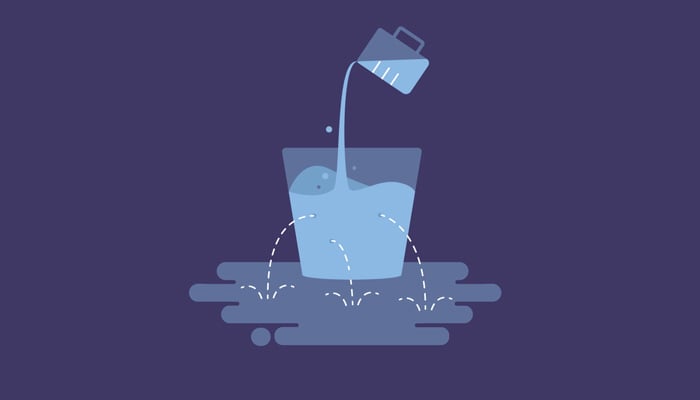Sustainable Growth Strategies: NRR and Sustainable Revenue in SaaS
Net Revenue Retention (NRR) is a key metric that measures the recurring revenue generated from existing customers over a specific period. NRR takes into account product upgrades, downgrades, and customer churn, showcasing the growth potential based on existing customer base.
Is your company experiencing sustainable growth?
If you were to answer, "Yes, we generate sustainable revenue because we are a SaaS model," it would be partially correct and partially incorrect. While the SaaS model should be sustainable, not all SaaS companies achieve sustainable growth.
Average churn rate of SaaS products
Simply put, if the cost of acquiring customers does not cover the cost and margin while retaining customers sufficiently, then it is not sustainable.
Customer churn is inevitable.

According to research by KBCM, the monthly churn rate (based on revenue, Churn rate) for SaaS companies with an average MRR of $2.49M (monthly revenue approximately 33 billion) is 3.5%, while companies with an MRR of $399K (approximately 5 billion) have a churn rate of 9.6%.
"In the industry, monthly churn rates above 5 percent are not considered healthy. This translates to an annual churn rate of about 46 percent, meaning that half of our annual sales are churn."
Richard Jo
Achieving sustainable growth goes beyond just market attractiveness.
If you've ever created IR presentations or new business plans to pitch to investors or key decision-makers, you've likely delved into the concepts of TAM-SAM-SOM to estimate market size.
In particular, TAM, or Total Addressable Market, represents the core element of market attractiveness within the entire business domain. It's a crucial number that investors pay close attention to when discussing market potential.
TAM involves researching the number of potential customers who can make a purchase and multiplying it by the average contract value, following a widely used formula:
TAM = (Average Contract Value) * (Total Number of Potential Customers)
However, when you actually start a business, you quickly learn that such market estimations can be far removed from reality, especially when entering new markets with innovative products.
Making that crucial difference often comes down to the fine details.
"Startups don't starve they drown"
Shawn Carolan
Ten years ago, in his book on Lean Startups, Eric Ries interpreted a statement from his mentor Shawn Carolan as follows:
"While there is a constant influx of new ideas on how to improve a product, the harsh reality is that the ideas that truly make a difference are often determined by the smallest details. It's about achieving some level of optimization. Startups should focus on large-scale experiments that lead to validated learning."
During times of favorable investment, there was room for a certain level of experimentation. It involved estimating the total addressable market with a new item, discussing strategies for the beachhead market (SOM, Service Obtainable Market), securing funding, and ramping up customer acquisition efforts. The question of sustainability was left unanswered, for now.
What you're selling is what customers want to buy.
The customer rarely buys what the company thinks it sells him.”
Peter Drucker
Amidst the rapidly increasing volatility in the capital markets, there is a growing emphasis on Peter Drucker's wisdom. It's a simple truth - in order to achieve sustainable growth, you must sell what customers want to buy. Investors are increasingly focused on the concept of 'sustainable growth'.
The necessity of measuring 'Net Revenue Retention (NRR)' as an indicator of sustainable growth is becoming more apparent.

NRR (Net Revenue Retention) - What is it?
NRR is a fundamental KPI that focuses on customer and financial performance. To grasp NRR, one must first understand Monthly Recurring Revenue (MRR) and its differences. MRR is used to predict total revenue by considering all active subscriptions in a specific month. On the other hand, NRR represents the proportion of revenue generated from existing customers, showcasing how a business grows through customer retention.
Where is NRR used?
NRR is a critical metric for companies with subscription-based revenue models like music streaming, OTT, and SaaS (Software as a Service). Any reductions or churn in accounts within a subscription model indicate significant issues related to product value propositions, pricing strategies, and customer experience.
Unfortunately, in most cases, businesses rely on Monthly Recurring Revenue (MRR) as the primary metric for subscription model performance. Since MRR includes both new and existing customers, potential issues like those mentioned above may be masked by high acquisition rates.
For businesses with subscription models like SaaS, sustainable growth comes from retaining existing customers and expanding their accounts. Therefore, it is essential to use Net Revenue Retention (NRR) which excludes new customers.
How is NRR measured?
To calculate NRR, subtract the lost revenue (due to changes in revenue or account reductions) from the total revenue (starting revenue + account expansions), and then divide this by the starting revenue amount.

For example, calculating the NRR for November 2022 would involve the following steps:
- Starting MRR: Monthly Recurring Revenue generated in October
- Expansion MRR: New revenue generated in November from upsells/cross-sells
- Contraction MRR: Revenue lost in November due to downgrades
- Churn MRR: Revenue lost in November due to customer churn
Benchmarking NRR for investment attraction
Companies with high Net Revenue Retention rates are more attractive to investors. In 2021, SaaS companies had NRR rates ranging from 60% to 148%, indicating predictable and scalable growth. The most successful SaaS companies in recent IPOs far exceeded an NRR of 120%. Notably, the NRR for the most successful IPO'd SaaS companies is as follows:
- Snowflake: 158%
- Twilio: 155%
- Elastic: 142%
NRR improvement strategies
If NRR exceeds 100%, it signifies an increase in subscription revenue from existing customers, while below 100% indicates a decrease. Understanding why customers are churning or downsizing and promptly adjusting strategies is crucial for sustainable growth.
To improve NRR, focus on three key areas:
- Preventing customer churn
- Limiting downgrades
- Enhancing upselling and cross-selling
The role of a Customer Success Manager is paramount in these efforts.
1. Preventing Customer Churn
The best way to prevent customer churn is to address the direct reasons for their departure.
Starting with easily improvable aspects, many SaaS companies face subscription cancellations due to customer support issues, so enhancing the self-service knowledge base with improved categories and search results is a good starting point. Following that, building a customer success team, investing in UX, improving features, and adjusting pricing should be the sequence of actions.
2. Restricting Downgrades
While downgrades can be used as a strategy to prevent customer cancellations when they demand it, they can have a negative impact on net revenue retention rates.
Voluntary downgrades often result from initially selecting the wrong product, purchasing out of necessity, or receiving upgrades prematurely. Therefore, it is crucial to assist customers in choosing the right plan that meets their needs when starting a subscription. If downgrades occur more frequently than expected, quick adjustments to pricing strategies, packaging, and value propositions are necessary.
3. Improving Upselling and Cross-Selling
Upselling and cross-selling directly impact the increase in net revenue retention rates.
Recent best practices involve strategies that remind customers of the value they derive from product usage without being pushy. For instance, Grammarly, a writing improvement tool, uses weekly insight emails summarizing user statistics to highlight the most beneficial aspects of the product. Additionally, by logging into their account, users are reminded of what they might be missing out on by not upgrading access permissions or purchasing new features.
Avoiding being too pushy is crucial; recent customers are more likely to churn or downgrade rapidly if pressured.
In conclusion,
It is now the time to shift from mere retention to high-quality retention.
Using net revenue retention (NRR) as an indicator of sustainable growth and taking actions to increase it is crucial. This way, transitioning to healthy growth and attracting investments even during times of high market volatility becomes possible.
Consult with Performas about solutions for improving net revenue retention (NRR) through RevOps strategies.
Hello, refer to the CRM marketing guidelines for achieving revenue growth.

Share this
You May Also Like
These Related Stories
RevOps Implementation Guide for Success
Mastering the SDR Role: Essential Skills and Success Tips


No Comments Yet
Let us know what you think